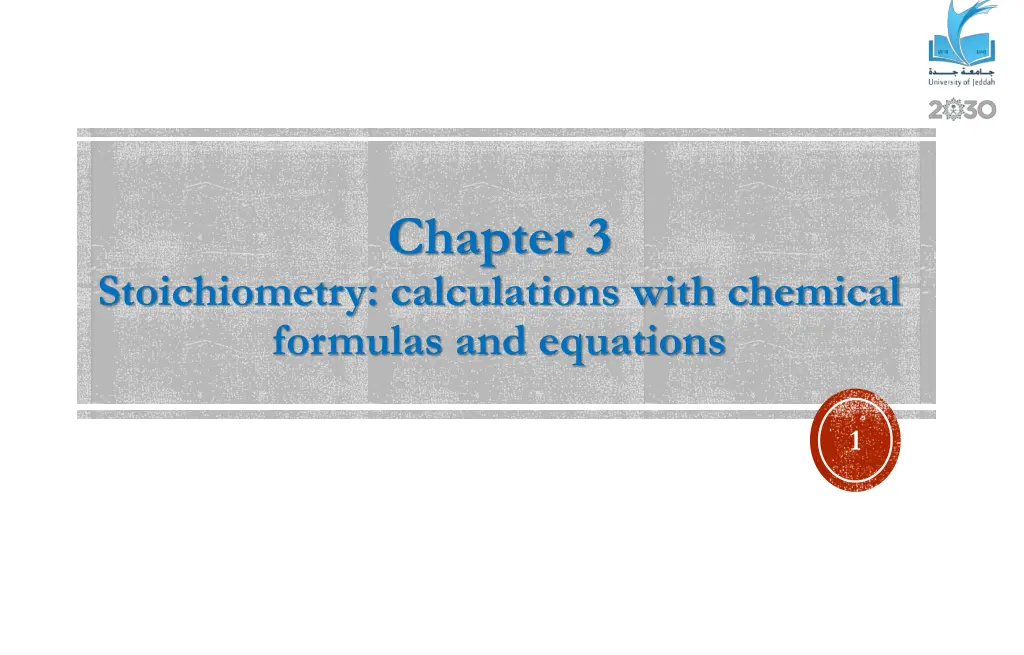
Understanding Stoichiometry in Chemistry
Explore the concept of stoichiometry in chemistry with calculations involving chemical formulas and equations. Learn about representing compounds, types of chemical formulas, and how to write empirical formulas. Dive into an atomic-level view of elements and compounds. Examples provided for better understanding.
Download Presentation

Please find below an Image/Link to download the presentation.
The content on the website is provided AS IS for your information and personal use only. It may not be sold, licensed, or shared on other websites without obtaining consent from the author. If you encounter any issues during the download, it is possible that the publisher has removed the file from their server.
You are allowed to download the files provided on this website for personal or commercial use, subject to the condition that they are used lawfully. All files are the property of their respective owners.
The content on the website is provided AS IS for your information and personal use only. It may not be sold, licensed, or shared on other websites without obtaining consent from the author.
E N D
Presentation Transcript
Chapter 3 Stoichiometry: calculations with chemical formulas and equations 1
Chapter 3 Stoichiometry: calculations with chemical formulas and equations Page:54-64 Representing compounds. An atomic level view of elements and compounds Ionic compounds Molecular compounds Writing and balancing chemical equation. 2
Chapter 3/Stoichiometry 3.2. Representing compounds: A compound is represented with its chemical formula. Chemical formula indicates the elements present in the compound and the relative number of atoms or ions of each. Example: Water is represented as H2O. Carbon dioxide is represented as CO2. Sodium Chloride is represented as NaCl. Carbon tetrachloride is represented as CCl4. 3
Chapter 3/Stoichiometry 3.2. Representing compounds: Types of Chemical Formulas 3- Structural formal ) use lines to represent covalent bonds. e.g. hydrogen peroxide H O O H 2- Empirical formula ) give the relative number of atoms of each element in compound. e.g. hydrogen peroxide HO 1- Molecular formula ) give the actual number of atoms of each element in compound. e.g. hydrogen peroxide H2O2 ( : ( : (: 4
Chapter 3/Stoichiometry 3.2. Representing compounds: Example: 1- What the Empirical Formula of H2O, C6H12O6 , O3 and N2H4? The empirical formula of H2O is H2O The empirical formula of C6H12O6 is CH2O (divide the numbers 6, 12 and 6 by the smallest common devisor 6) The empirical formula of N2H4 is NH2 2- Write the empirical formulas for the following molecules: 1. Acetylene (C2H2) CH 2. Nitrous oxide (N2O) N2O 3. Caffeine C8H10N4O2 C4H5N2O Divide all the numbers by the smallest common devisor. 5
Chapter 3/Stoichiometry 3.2. Representing compounds: Example 3.1 p55: Write the empirical formulas for the following molecules: (a) C4H8, the greatest common factor is 4 The empirical formula is therefore CH2. (b) B2H6 the greatest common factor is 2 The empirical formula is therefore BH3. (c) CCl4 the only common factor is 1, The empirical formula and the molecular formula are identical. 6
Chapter 3/Stoichiometry 3.3. An atomic level view of elements and compounds 7
Chapter 3/Stoichiometry 3.3. An atomic level view of elements and compounds Atomic element: Are elements that exist in nature with single atoms as their unite. Molecular element: Are elements that exist as molecule two or more atoms bonded together. 1- diatomic molecule: H2, N2, O2, F2, Cl2, Br2, and I2. 2- polyatomic molecule e.g. P4 and S8 Ionic compound: Are composed of cation (metal) and anion (nonmetal) bound together by ionic bond. 1- Binary ionic compounds e.g. NaCl 2- polyatomic ions compound e.g. NaNO3 Molecular compound: Are composed of two or more atoms covalently bonded nonmetal. 8
Chapter 3/Stoichiometry 3.4. Ionic Compounds: formal and Naming Ionic Compounds Anion Cation consist of a combination of cations and an anions, e.g.: Na+ and Cl- NaCl The sum of the charges on the cation/s and anion/s in each formula unit must equal zero. The formula of the ionic compound must be neutral. 1- Binary compounds are compounds formed from just two elements. 2- polyatomic ions: are ionic compounds contain ions that are themselves composed of a group of covalently bonded atoms with an overall charge. Example: NaNO3 contains Na+ and NO3 . CaCO3 contains Ca2+ and CO32 . KClO Contains K+ and ClO 9
Chapter 3/Stoichiometry 3.4. Ionic Compounds: formal and Naming How to make the formula neutral? Potassium Bromide Zinc Chloride The subscript of the cation is numerically equal to the charge on the anion, and the subscript on the anion is numerically equal to the charge on the cation. K+ Br- Zn2+ Cl- ZnCl2 KBr 10
Chapter 3/Stoichiometry 3.4. Ionic Compounds: formal and Naming How to make the formula neutral? 2 x (+3) = +6 3 x (-2) = -6 Al2O3 Al3+ O2- The subscript of the cation is numerically equal to the charge on the anion, and the subscript on the anion is numerically equal to the charge on the cation. 1 x (+2) = +2 2 x (-1) = -2 CaBr2 Ca2+ Br- 1 x (+2) = +2 1 x (-2) = -2 Na2CO3 Na+ CO32- 11
Chapter 3/Stoichiometry 3.4. Ionic Compounds: formal and Naming 1- Ionic Binary compounds can be categorized into two types, depending on the metal in the compound. The ion always has the same charge. The ion has the different charge. 12
Chapter 3/Stoichiometry 3.4. Ionic Compounds: formal and Naming 1.1 Naming Binary Ionic Compounds of Type I Cations The names of binary ionic compounds take the following form: Example: 1- The name for KCl consists of the name of the cation, potassium, followed by the base name of the anion, chlor, with the ending -ide. KCl potassium chloride. 2- The name for CaO consists of the name of the cation, calcium, followed by the base name of the anion, ox, with the ending -ide. CaO calcium oxide. 13
Chapter 3/Stoichiometry 3.4. Ionic Compounds: formal and Naming 1.1 Naming Binary Ionic Compounds of Type I Cations Table 3.2.Base Names of some common Anions 14
Chapter 3/Stoichiometry 3.4. Ionic Compounds: formal and Naming 1.2 Naming Binary Ionic Compounds of Type II Cations Metals of this type are often transition metals. Some main group metals, such as Pb, Tl, and Sn, form more than one type of cation. Example: FeSO4 iron is +2 cation (Fe2+). Fe2(SO4)3 iron is +3 cation (Fe3+). Cu2O copper is +1 cation (Cu+). CuO copper is +2 cation (Cu2+). 15
Chapter 3/Stoichiometry 3.4. Ionic Compounds: formal and Naming 1.2 Naming Binary Ionic Compounds of Type II Cations Roman numerals we distinguish between Fe2+ and Fe3+ as follows: Fe2+ Fe3+ Iron(II) Iron(III) I One II two III Three Example: IIII Four IV Five FeCl2 Iron (II) chloride FeCl3 Iron (III) chloride Cr2S3 chromium(III) sulfide 16
Chapter 3/Stoichiometry 3.4. Ionic Compounds: formal and Naming 1.2 Naming Binary Ionic Compounds of Type II Cations Table Table 3.3 3.3 17
Chapter 3/Stoichiometry 3.4. Ionic Compounds: formal and Naming Ionic Binary compounds 1- Metals form only one type of cation: 2- Metals form more than one type of cation: Transition Metals. Alkali metals. Alkali earth metals. other metal cations. Ag+, Al3+, Cd2+, Zn2+ 18
Chapter 3/Stoichiometry 3.4. Ionic Compounds: formal and Naming 2. Naming Ionic Compounds Containing Polyatomic Ions Ionic compounds that contain a polyatomic ion is name in the same way as other ionic compounds, except that we use the name of the polyatomic ion whenever it occurs. Example: NaNO2 is named according to its cation, Na+ sodium its polyatomic anion, NO2 nitrite NaNO2 sodium nitrite 19
Chapter 3/Stoichiometry 3.4. Ionic Compounds: formal and Naming 2. Naming Ionic Compounds Containing Polyatomic Ions Most polyatomic ions are oxyanions anions containing oxygen and another element. 1-If there are two ions in the series, 2- If there are more than two ions in the series The one with more O2 atoms has the ending -ate, e.g. NO3 nitrate the prefixes per-, meaning more than, ClO hypochlorite ClO2 chlorite ClO3 chlorate ClO4 perchlorate The one with fewer has the ending -ite. e.g. NO2 nitrite the prefixes hypo-, meaning less than, 20
Chapter 3/Stoichiometry 3.4. Ionic Compounds: formal and Naming 2. Naming Ionic Compounds Containing Polyatomic Ions Table Table 3.4 3.4 21
Chapter 3/Stoichiometry 3.4. Ionic Compounds: formal and Naming 2. Naming Ionic Compounds Containing Polyatomic Ions Example: Name the following compounds: (a) Cu(NO3)2 1. Cation: Copper cation (can form two types of cation) Copper (II) 2. Anion: NO3- anion has a common name Nitrate Thus: the name of the compound is: Copper (II) nitrate (b) KH2PO4 1. Cation: K form only one type of cation Potassium Note: not potassium (I) 2. Anion: H2PO4- has a common name dihydrogen phosphate Thus: the name of the compound is: Potasium dihydrogen phosphate 22
Chapter 3/Stoichiometry 3.4. Ionic Compounds: formal and Naming Example 3.7 p62: Determine the name for the compound Li2Cr2O7 ? 23
Chapter 3/Stoichiometry H.W 4, 12, p73 24
Chapter 3/Stoichiometry 3.5. Molecular Compounds: Formulas and Names Molecular compounds are composed of two or more nonmetals. The formula for a molecular compound cannot readily be determined from its constituent elements (why?) because the same combination of elements may form many different molecular compounds, each with a different formula. Example: Nitrogen and oxygen form all of the following unique molecular compounds: NO NO2 N2O N2O3 N2O4 N2O5 25
Chapter 3/Stoichiometry 3.5. Molecular Compounds: Formulas and Names How to write the name of Molecular Compounds? 1- write the name of the element with the smallest group number first. e.g. HCl hydrogen chloride If the two elements lie in the same group, then write the element with the greatest row number first. e.g. SO2 sulphur dioxide 2- The prefixes given to each element indicate the number of atoms present. If there is only one atom of the first element in the formula, the prefix mono- is normally omitted. 26
Chapter 3/Stoichiometry 3.5. Molecular Compounds: Formulas and Names 27
Chapter 3/Stoichiometry 3.5. Molecular Compounds: Formulas and Names Mono- is omitted if its in the first element. HCl Hydrogen chloride Example: e.g. Monocarbon monoxide SiC Silicone carbide Carbon monoxide CO Carbon monoxide monooxide monoxide CO2 Carbon dioxide the o is omitted SO2 Sulphur dioxide SO3 Sulphur trioxide tetraoxide tetroxide the a is omitted NO2 Nitrogen dioxide N2O4 Dinitrogen tetroxide 28
Chapter 3/Stoichiometry 3.5. Molecular Compounds: Formulas and Names Example: Name the following molecular compounds: (a) SiCl4 One silicon atom & four chlorine atoms Thus: Silicon tetrachloride (b) P4O10 Four phosphourus atoms & ten oxygen atoms Thus: Tetraphosphourus decoxide decaoxide the a is omitted 29
Chapter 3/Stoichiometry 3.5. Molecular Compounds: Formulas and Names Example: Write chemical formulas for the following molecular compounds: (a) carbon disulphide There is one carbon atom & two sulphur Atoms, Thus: CS2 (b) Disilicon hexabromide There is two silicon atoms & six bromine Atoms, Thus: S2Br6 30
Chapter 3/Stoichiometry 3.5. Molecular Compounds: Formulas and Names Acids: are molecular compounds that form H+ when dissolved in water. To indicate the compound is dissolved in water (aq) is written after the formula. e.g. HCl dissolved in water, H+(aq)and Cl (aq) ions A compound is not considered an acid if it does not dissolve in water. Characters of acids: Sour taste Dissolve many metals such as Zn, Fe, Mg; but not Au, Ag, Pt Formula generally starts with H e.g., HCl, H2SO4 1. 2. 3. 31
Chapter 3/Stoichiometry 3.5. Molecular Compounds: Formulas and Names Acids can be categorized into two types have H+ cation and polyatomic anion. have H+1 cation and nonmetal anion. 32
Chapter 3/Stoichiometry 3.5. Molecular Compounds: Formulas and Names How to Naming Binary Acids? Write a hydro- prefix. Follow with the nonmetal name. Change ending on nonmetal name to ic. Write the word acid at the end of the name. 1. 2. 3. 4. Example: HCl Hydrochloricacid HBr Hydrobromic acid 33
Chapter 3/Stoichiometry 3.5. Molecular Compounds: Formulas and Names Example 3.9 p64 1- Determine the name for the compound HI(aq)? 2-Determine the name for the compound HF(aq)? 34
Chapter 3/Stoichiometry H.W 14, 15, p73 35 35


